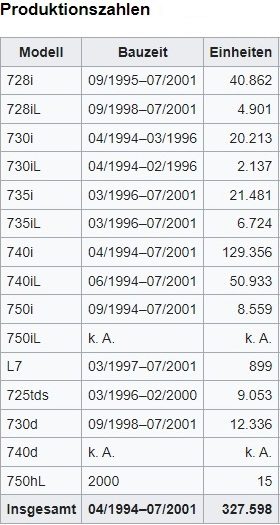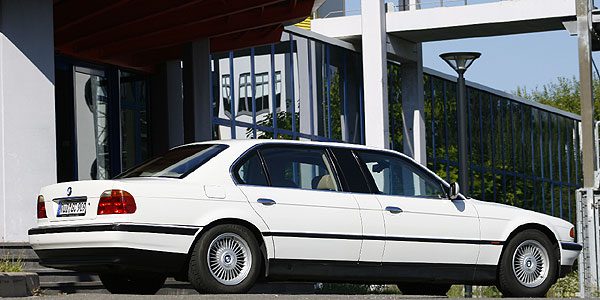The E38 series is the third generation of the BMW 7 series in the luxury class. It was introduced in June 1994 as the successor to the BMW E32. In this series, a completely newly developed integral rear axle was used for the first time. The BMW E38 was also the first car from a European manufacturer to be offered with a navigation system ex works. The third generation of the BMW 7 Series E38 series was built from 1994 to July 2001 at the BMW Dingolfing plant, 327,598 units. The successor models were E65, E66, E67 and E68.

The models 730i and 740i were initially offered for the market launch in June 1994. They have the eight-cylinder M60 V-engine with a displacement of 3.0 or 4.0 liters. While the 730i was delivered with a five-speed manual transmission as standard, the 740i received a newly developed six-speed manual transmission. The BMW 750i followed in autumn 1994, the twelve-cylinder M73 V-engine with a displacement of 5.4 liters and an output of 240 kW (326 hp). It is linked to a five-speed automatic transmission. In autumn 1995, the 728i with the six-cylinder in-line engine M52 with 142 kW (193 hp) was introduced as the new basic engine.
In March 1996 the M60 engines were replaced by the new M62 engine series. The displacement of the 3.0 and 4.0 liter engines was increased to 3.5 liters (735i) and 4.4 liters (still referred to as 740i). The maximum torque increased from 290 Nm to 320 Nm or from 400 Nm to 420 Nm. The 735i now developed 175 kW (235 hp) instead of 160 kW (218 hp). The rated output of the 740i remained unchanged at 210 kW (286 hp). From April 1996 the 725tds was available with a six-cylinder diesel engine with swirl chamber injection and 105 kW (143 hp).

From September 1994 a navigation system was offered as an option for the BMW E38. It was the first car from a European manufacturer that was optionally available from the factory with a navigation system. Its 4: 3 monitor also has a TV function (analog), which could only be used when the vehicle was at a standstill.

BMW 7er E38 Navi 4:3 mit Navi CD bis Baujahr 2000
From the year of construction at the end of 2000, the navigation display was in 16: 9 and from 2001 onwards with the MK 3 and MK 4 it also has a DVD drive instead of just a CD as before. The advantage was that from then on no CD had to be exchanged, e.g. if you wanted to drive from Bremen to Barcelona. From then on, all the data and maps of Europe were only on one DVD.

BMW 7 series E38 with on-board monitor 16: 9
From September 1996, the standard equipment included side airbags for the driver and front passenger. The ITS head airbags, which were available as special equipment from June 1997, were standard equipment from September 1997.

In September 1997, the standard equipment was expanded to include side airbags for the rear and in spring 1999 head airbags for the rear.

The 7 Series was modified in autumn 1998. The vertical struts in the BMW kidneys, the front headlights and the rear lights have now been redesigned in clear glass. The side skirts were now continuous. There was a chrome strip on the tailgate.

Für die Achtzylindermotoren wurde die variable Nockenwellensteuerung VANOS eingeführt. Diese steigert die Leistung des 735i auf 175 kW (238 PS) und das maximale Drehmoment auf 345 Nm. Die Leistung des 740i blieb nominal unverändert bei 210 kW (286 PS), das maximale Drehmoment wurde auf 440 Nm aufgehoben. Fortan wurden 735i und 740i ausschließlich mit dem Fünfgangautomatikgetriebe des Typs ZF 5HP24 geliefert. Der Sechszylindermotor des 728i erhielt Doppel-VANOS. Neu im Programm war das Modell 730d mit einem 3,0-Liter-Sechszylinder-Dieselmotor mit Common-Rail-Direkteinspritzung. Er leistete zunächst 135 kW (184 PS) und erzeugte ein maximales Drehmoment von 410 Nm. Wie 735i und 740i ist ebenfalls an das 5HP24-Getriebe gebunden. Der 725tds ab Herbst 1998 wurde nur noch in einigen wenigen angeboten.
Ab Mitte 1999 war der 740d mit einem 3,9-Liter-V8-Biturbo-Dieselmotor mit Common-Rail-Direkteinspritzung im Programm. Dessen Leistung wurde zunächst mit 175 kW (238 PS) angegeben, ab Markteinführung schließlich mit 180 kW (245 PS). Sein Drehmoment betrug 560 Nm.Damit war der 740d der leistungsfähigste Diesel-Pkw auf dem Markt. Im Frühjahr 2000 wurde die Leistung des 730d auf 142 kW (193 PS) gesteigert, während das maximale Drehmoment auf 430 Nm stieg.
Modelle ab April 1999 wurden nun mit der „Haifischflossen-Antenne“ geliefert. Des Weiteren gab es eine Überarbeitung der Schalter für die Sitzheizung vorne sowie für die elektrische Lenkradhöhenverstellung. Auch war die Funktion „Heimleuchten“ möglich. Beim Verlassen des Wagens konnte man den Weg beleuchten. Mit dem Juni 2000 war der Navigationsrechner „MK3“ verfügbar mit dem Bordmonitor 16:9. Das Kassettendeck befindet sich fortan hinter dem Gerät, das elektrisch auszuklappen war.
Am 27. Juli 2001 lief der letzte BMW E38 vom Band.
The E38 in old age
The E38 corresponds to the sporty, filigree design line that shaped BMW for many years. The successor type E65 follows a different, polarizing design. This is why the E38 IS commonly referred to as the last beautiful 7 Series, but technically it is the first 7 Series to feature complex electronics, including the CAN bus system. Together with the extensive electrical (comfort) equipment, the E38 places much higher demands on its age than its predecessor. The chassis wears out comparatively quickly, and the multi-link rear axle means increased repair costs. In contrast to the solid manual transmissions, the automatic transmissions are sometimes prone to failure with age. The engines are considered to be solid, although the maintenance effort increases with the number of cylinders. A noticeable weak point of the 740i is the oil pump that comes loose. The corrosion protection of the E38 is good. Rust is more likely to cause problems in the cosmetic area, as well as on the sill ends and the jack mount. The spare parts supply is considered good.
Long versions
The BMW 7 Series of the E38 series was built exclusively as a four-door notchback sedan.

From autumn 1994, the variants equipped with a gasoline engine were also available as a long version. The model names of the long versions contain an additional “L”. The wheelbase of these vehicles has been lengthened by 14 centimeters. The space created in this way is only used by the rear passengers.

L7
From 1997 BMW manufactured the L7. This is based on the 750iL and has been extended by another 25 centimeters on the B-pillar in favor of the fund. Thus the L7 was 39 centimeters longer than the short version. The selling price was 246,000 Deutschmarks. 899 copies rolled off the line.
In 1996, the fashion designer Karl Kagerfeld, together with BMW Individual GmbH, created a unique vehicle based on an E38 750iL which was intended as a VIP shuttle for the Four Seasons Palace in Berlin. The idea was to give the arriving guests the same ambience as they were in the castle when they were picked up.


The E38 also made its film debut in the 18th James Bond film “Tomorrow Never Dies”, which was released in 1997.


Security vehicles
Sales of the 740iL Protection Line and 750iL Protection Line security vehicles began in the second quarter of 1999. They have body armor with aramid fiber mats and protective glazing. The additional protective measures brought an additional weight of approx. 145 kg. The standard equipment also includes tires with emergency running properties. The 750iL Security Line offers even greater protection.